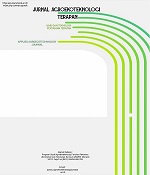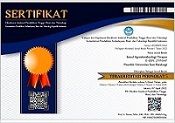Application Of High Punking Water, Phonska Fertilizer And Compost In Rice Rice Production (Oryza sativa L.) In Taratara One Village Tomohon West District Tomohon City
DOI:
https://doi.org/10.35791/jat.v3i2.44336Abstract
This research was conducted in the field, aiming to determine the effect of high stagnant water, phonska fertilizer and compost on lowland rice production. Things observed included finding the optimum dose of phonska fertilizer and compost at each stagnant height. The study was designed using a split plot design in which the Waterlogging Height consisted of two levels (To = 1.0 cm and Tx = 10.0 cm) as the main plot, Phonska fertilizer dosage, consisting of three levels (1 = 0.0 tons /ha; 2 = 0.15 ton/ha; 3 = 0.3 ton/ha) as sub-plots and dosage of compost, consisting of two levels (a = 0.0 ton/ha and b = 20 ton/ha) as sub-plots. Repeated three times, so there will be 36 trial plot units. The data in this study consist of: 1). rice production (dry grain), 2). plant height; and 3). supporting data consists of: 1). soil chemical and physical properties. 2). air temperature, 3). rainfall, and 4). pests and plant diseases. Analysis of the variation in the effect of treatment on paddy rice plant production used the F test (ANOVA) at the 5% level. If there is variation, proceed with the LSD test at the 5% level (Steel and Torrie, 1991).
The results showed that statistically there was no difference in the production of rice plants planted at a height of 1 cm (To) and 10 cm (Tx). The highest production was in the To treatment, namely at a dose of 0.3 tons/ha of phonska fertilizer and 20 tons/ha of compost: 2.737 kg/4.48 m2 of dry milled grain or equivalent to 6.11 tons/ha. In the Tx treatment, namely at a dose of 0.3 tons/ha of phonska fertilizer and 20 tons/ha of compost: 3.508 kg/4.48 m2 of dry milled grain or equivalent to 7.83 tons/ha. The difference in rice production between the To and Tx treatments was around 21.99%.
Keywords: Inundation height, Phonska, Compost, Paddy Field
Abstrak
Penelitian ini dilakukan di lapangan, bertujuan untuk untuk mengetahui pengaruh tinggi genangan air, pupuk phonska dan kompos terhadap produksi padi sawah. Hal yang diamati meliputi mencari dosis optimum pupuk phonska dan kompos pada masing-masing tinggi genangan air. Penelitian dirancangan secara split split plot design di mana Tinggi Genangan Air terdiri atas dua taraf (To = 1,0 cm dan Tx = 10,0 cm) sebagai main plot, dosis pupuk Phonska, terdiri atas tiga taraf (1 = 0,0 ton/ha; 2 = 0,15 ton/ha; 3 = 0,3 ton/ha) sebagai sub plot dan dosis pupuk Kompos, terdiri atas dua taraf (a = 0,0 ton/ha dan b = 20 ton/ha) sebagai sub sub plot. Diulang tiga kali, sehingga akan terdapat 36 satuan petak percobaan. Data dalam penelitian ini terdiri: 1). produksi padi (gabah kering), 2). tinggi tanaman; dan 3). data penunjang terdiri atas: 1). sifat kimia dan fisik tanah. 2). suhu udara, 3). curah hujan, dan 4). hama dan penyakit tanaman. Analisis keragaman pengaruh perlakuan terhadap produksi tanaman padi sawah digunakan uji F (ANOVA) pada taraf 5 %. Bila terdapat keragaman dilanjutkan dengan uji BNT pada taraf 5 % (Steel dan Torrie, 1991).
Hasil penelitian diperoleh bahwa secara statistik tidak terdapat perbedaan produksi tanaman padi yang ditanam pada tinggi genangan air 1 cm (To) dengan 10 cm (Tx). Produksi tertinggi pada perlakuan To, yaitu pada dosis pupuk phonska 0,3 ton/ha dan kompos 20 ton/ha sebanyak : 2,737 kg/4,48 m2 gabah kering giling atau setara 6,11 ton/ha. Pada perlakuan Tx, yaitu pada dosis pupuk phonska 0,3 ton/ha dan kompos 20 ton/ha sebanyak : 3,508 kg/4,48 m2 gabah kering giling atau setara 7,83 ton/ha. Selisih produksi padi antara perlakuan To dan Tx adalah sekitar 21,99 %.
Kata kunci : Tinggi genangan, Phonska, Kompos, Padi Sawah
Downloads
Published
How to Cite
Issue
Section
License
Copyright (c) 2022 Yani E. B Kamagi, Joice M. J Supit, Wiesje J. N Kumolontang

This work is licensed under a Creative Commons Attribution-NonCommercial 4.0 International License.

This work is licensed under a Creative Commons Attribution-NonCommercial 4.0 International License.




















